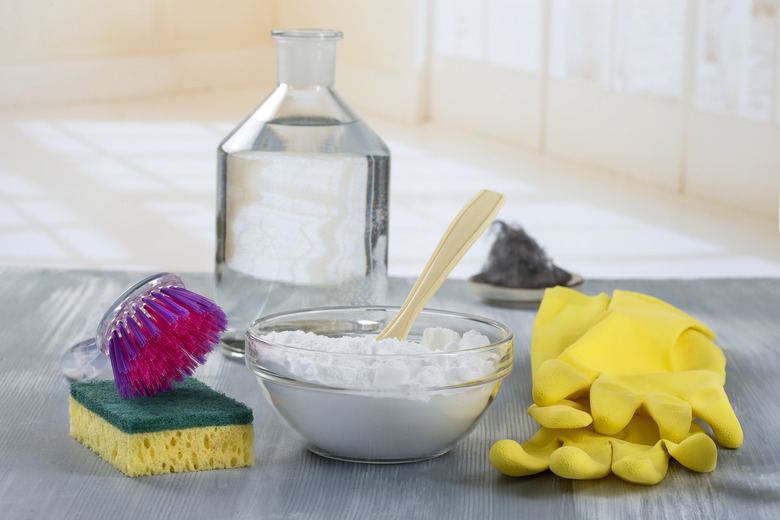List Of Household Bases & Acids
A chemical base (or alkaline) is a substance that accepts H+ or hydrogen ions. It dissociates in water and is a good conductor of electricity. A base turns litmus paper blue, which indicates its alkalinity. An acid is a compound that dissolves in water to release hydrogen ions. Acids and bases are generally chemically active in that they can react with many other substances. As a result, they are commonly found in various household applications, especially as cleaners and in the kitchen.
Baking Soda
Baking Soda
Baking soda is the common name for sodium bicarbonate, known chemically as NaHCO3. It is also called bicarbonate of soda, cooking soda and bread soda. Baking soda is produced by the reaction of carbon dioxide, ammonia, sodium chloride (salt) and calcium carbonate in water. Naturally occurring deposits of the compound are mined from geological formations of the Eocene age (approximately 48 million years ago). The Green River Formation (Piceance Basin) in Colorado is a major source of sodium bicarbonate. Baking soda is primarily used for baking. It reacts with other ingredients to release carbon dioxide, which helps the dough rise. A diluted solution of household baking soda can treat heartburn and indigestion. It functions as a mouthwash, treats gum diseases and relieves insect bites. A hydrogen peroxide and sodium bicarbonate paste can be used as an alternative to commercial toothpaste. Baking soda is an effective cleaning agent and removes heavy stains (wine, tea and coffee) from cups and fabric.
Diluted Soaps
Diluted Soaps
Potassium or sodium hydroxide (KOH or NaOH) react with triglycerides to form soap (the process is called saponification, the reaction of a strong alkali with fats and oils). Soap is alkaline in nature and is an effective cleansing agent. It is a useful mild antiseptic and can treat heavy metal poisoning. A diluted solution of soap makes an effective insecticide when sprayed on garden plants.
Household Ammonia
Household Ammonia
Household ammonia (ammonium hydroxide) is a common base, and is an effective tarnish and stain remover. It is used to clean gold and silver jewelry, porcelain, glass, stainless steel, brassware and a variety of stains (blood, perspiration, red wine stains and pen markings).
Household Vinegars
Household Vinegars
Vinegar is a common household acid that is made from fermented ethanol, acetic acid and small amounts of citric acid and tartaric acid. There are various varieties of vinegar, including malt, wine, apple cider, palm, date, balsamic and honey vinegar. Vinegar is commonly used in the preparation of pickles, vinaigrettes, salad dressings and sushi rice and flavorings. White vinegar is a common cleaning agent, and is used to remove tough deposits from coffee makers, glass and other smooth surfaces. It is also effective against lawn weeds.
Citric Acid
Citric Acid
Citric acid is used as an additive in foods, as a preservative and an effective cleaning agent. It is naturally found in certain fruits, such as oranges and lemons.
Cite This Article
MLA
, Natasha Gilani. "List Of Household Bases & Acids" sciencing.com, https://www.sciencing.com/list-household-bases-acids-7228196/. 27 April 2018.
APA
, Natasha Gilani. (2018, April 27). List Of Household Bases & Acids. sciencing.com. Retrieved from https://www.sciencing.com/list-household-bases-acids-7228196/
Chicago
, Natasha Gilani. List Of Household Bases & Acids last modified March 24, 2022. https://www.sciencing.com/list-household-bases-acids-7228196/
